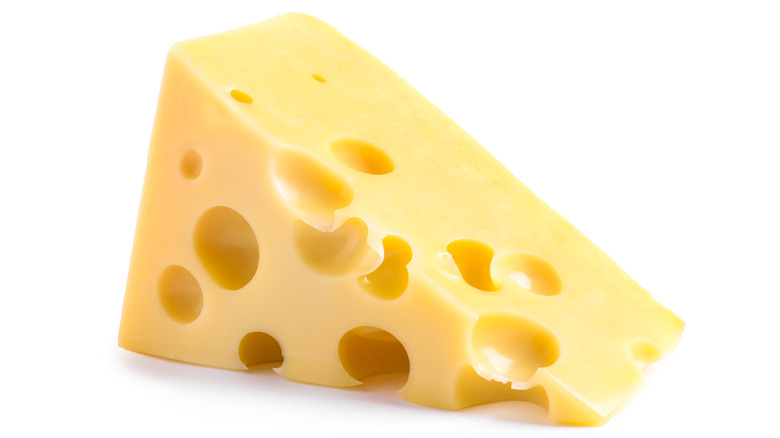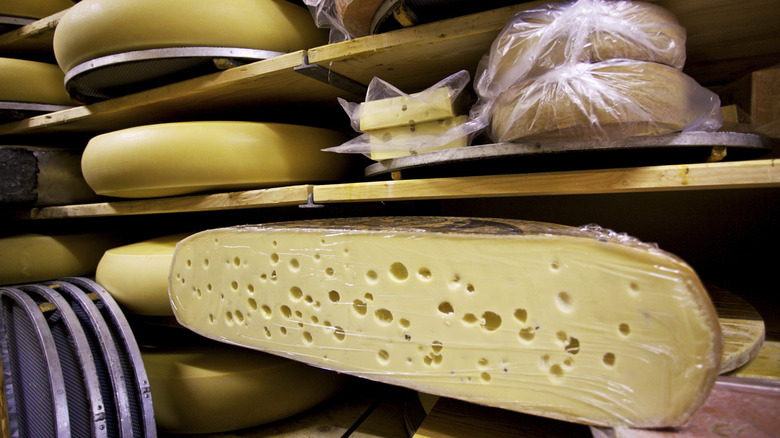What Makes Holes In Swiss Cheese?
All right folks, time to answer one of life's grandest questions: Why does my cheese come pre-holed? Thankfully, it's not because some cartoon rat nibbled through it while it was chilling out in a storage. It's also not accidental — at least, not anymore. The holes in Swiss cheese are the by-product of something you might not have thought about since high school: chemistry.
Cheese, like beer, is a little chemical miracle birthed in bacteria. The cheese-mongers at S. Clyde Weaver describe the overall cheesemaking process. Snag some lactating animal, filch their baby's food, chuck it in a bucket, toss in some bacteria, let it congeal into "curds" (solid bits) and "whey" (liquid bits), drain the whey and keep the curds, cut the curds and add other ingredients like salt, and presto: instant chewable milk. This is why it's easy to imagine the first cheese was an accident. (Whoops, the milk went bad. Grab a fork.)
Each kind of cheese, down to the animal milked, requires a different process. In the case of Swiss cheese, which indeed came from Switzerland (in the 15th century, per The Conversation), cheesemakers use three kinds of bacteria: Streptococcus thermophilus, Lactobacillus, and (deep breath) Propionibacterium freudenrichii subspecies shermanii. The burgeoning curds are kept at a warm temperature (70 degrees Fahrenheit), which not only makes the cheese flexible, but lets its bacteria produce carbon dioxide. Gas bubbles bore through the cheese and make little round openings. Wait four weeks and you've got some wholly holey cheese.
Big, round eyes and warm bacteria
Swiss cheese, known as "emmental" or "emmentaller" in Switzerland and other countries, isn't the only holey cheese. Gruyere, fontina, and baby Swiss are also intentionally allowed to perforate. Typically, as The Conversation points out, cheesemakers do their darndest to eliminate, or at least reduce, such "eyes" (the holes' official name) and other "imperfections" like cracks, crevices, splits, and seams. Swiss cheese gets its big, round eyes in large part because it's bacterial process occurs at a higher temperature. Its softness allows for expansive, smoothbore goodness.
The experts at Shisler's Cheese House go into greater detail about the cheesemaking, storage, and aging process. It might take only four weeks for Swiss cheese to be ready, but some cheeses, like Parmigiano-Reggiano, ought to age for two years or more if you want subtler, fruitier flavors to emerge. Some cheddars, per Golden Age Cheese, can be aged for over a decade. In general, the longer something is aged, the harder and crumblier it gets. Not only age and temperature matter, as with Swiss cheese, but so do humidity, light, and plenty of other processes like curd washing. And in case you were wondering, yes, the blue in bleu cheese is a "fissure" of sharp, tasty, bacteria-built mold, possibly even from injected penicillin. Yum yum.
As Mental Floss states, the size of cheeses' eyes matters, too. In 2000, the FDA ruled that "Grade-A" (the highest) Swiss cheese needed to contain holes precisely within 3/8 and 13/16 of an inch in diameter.

